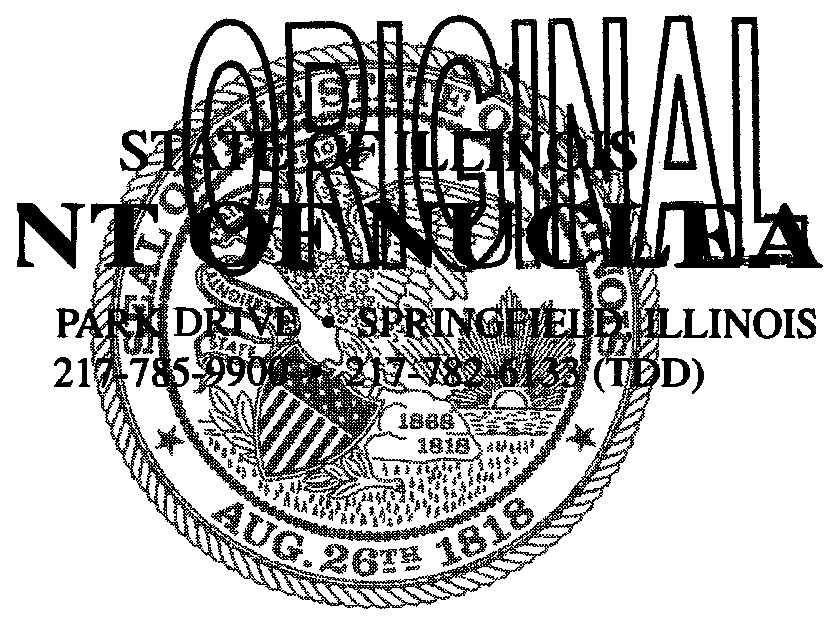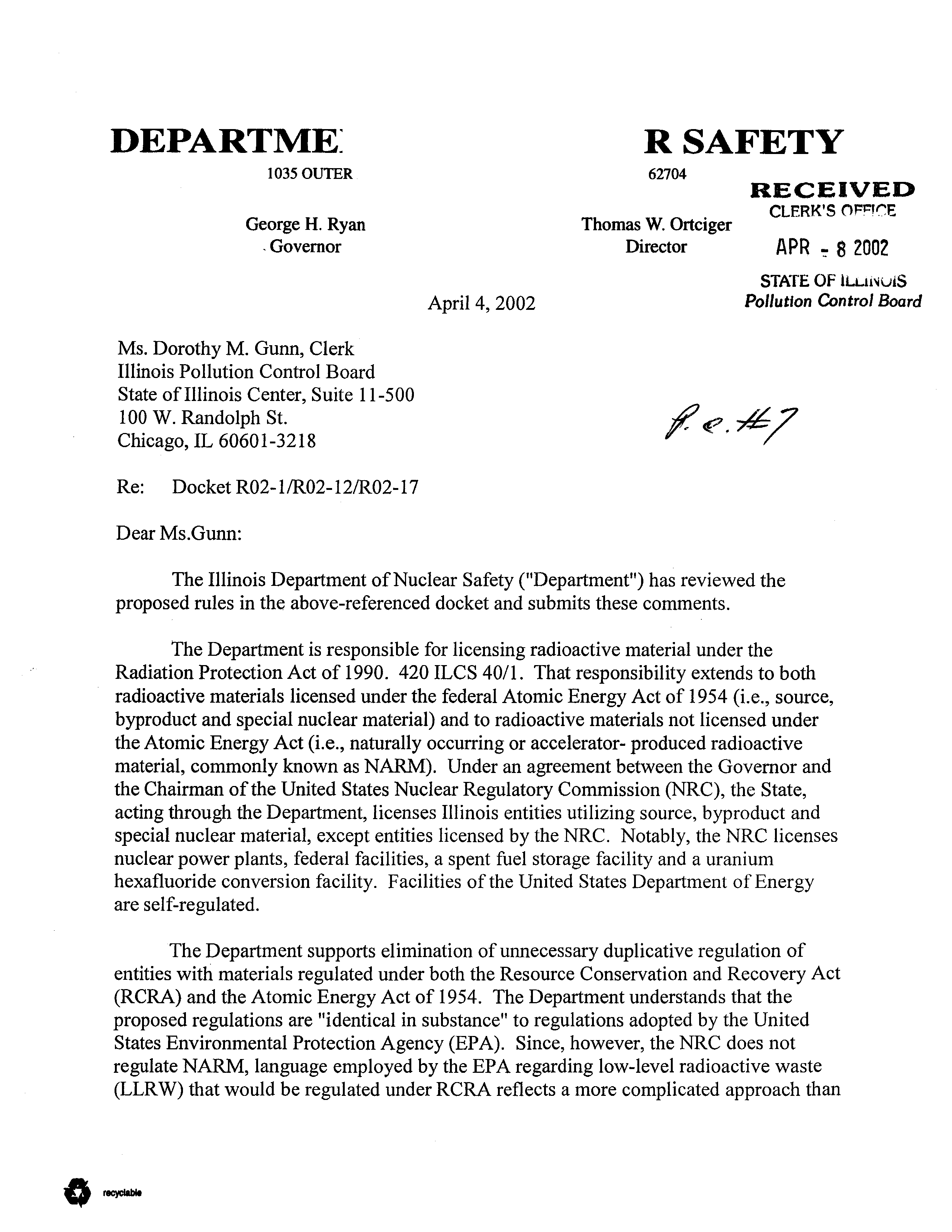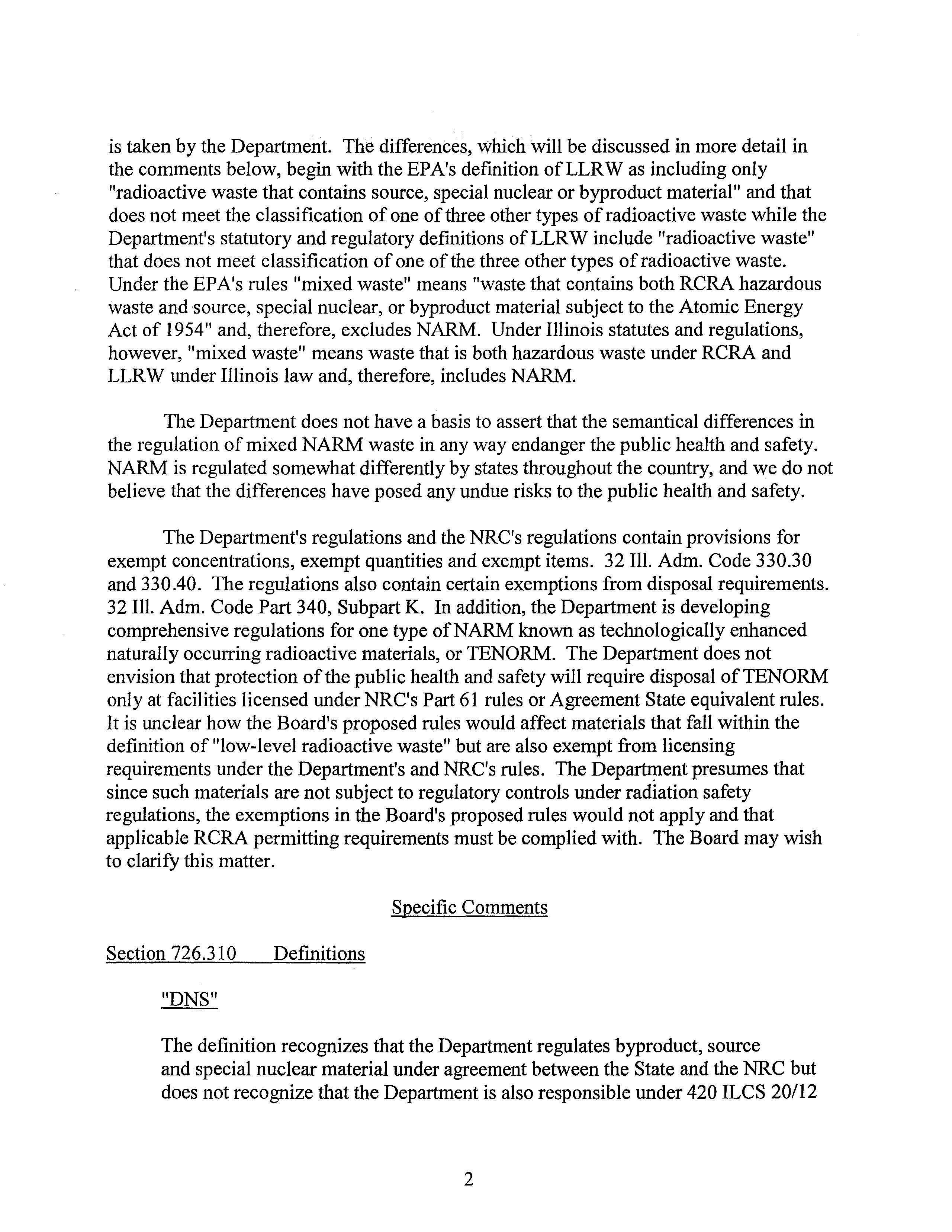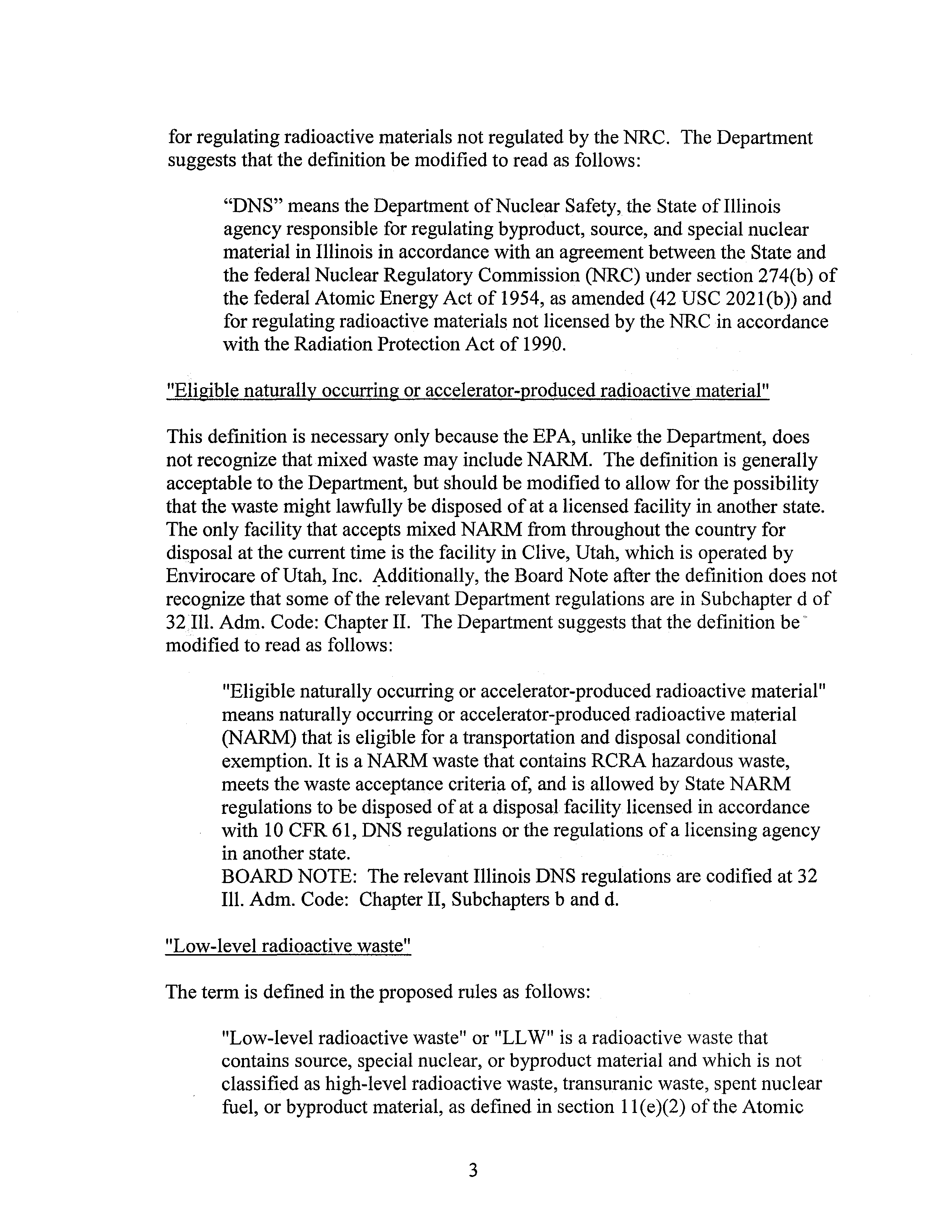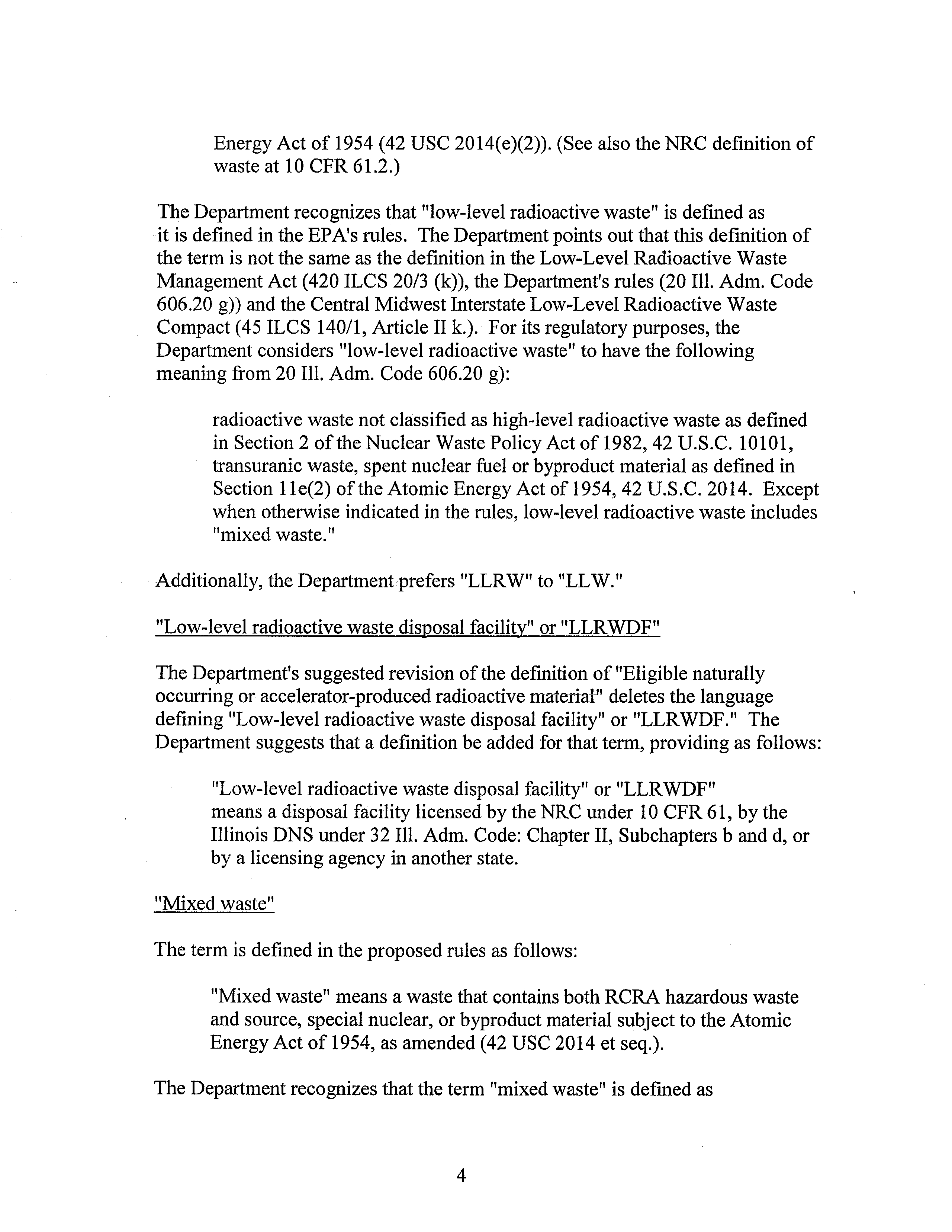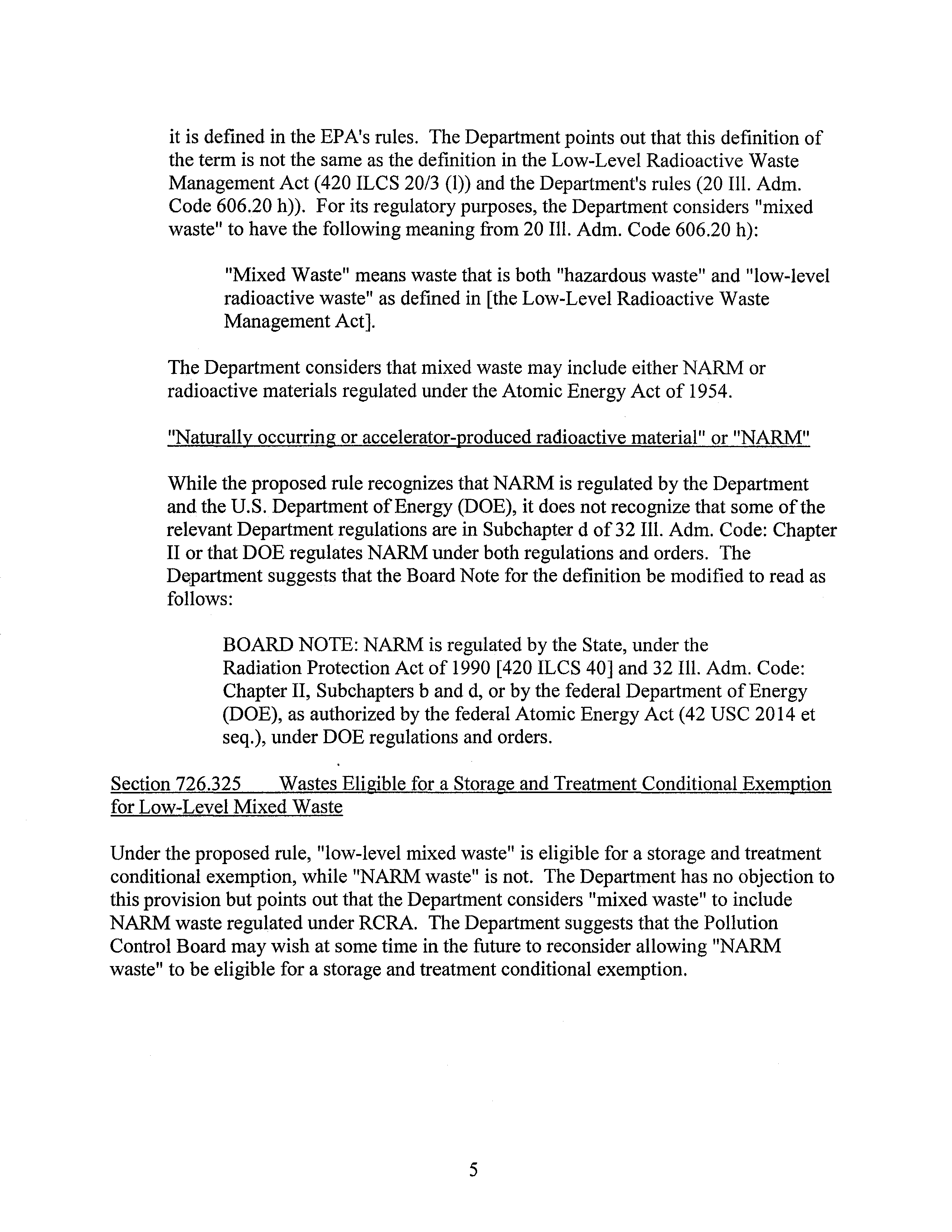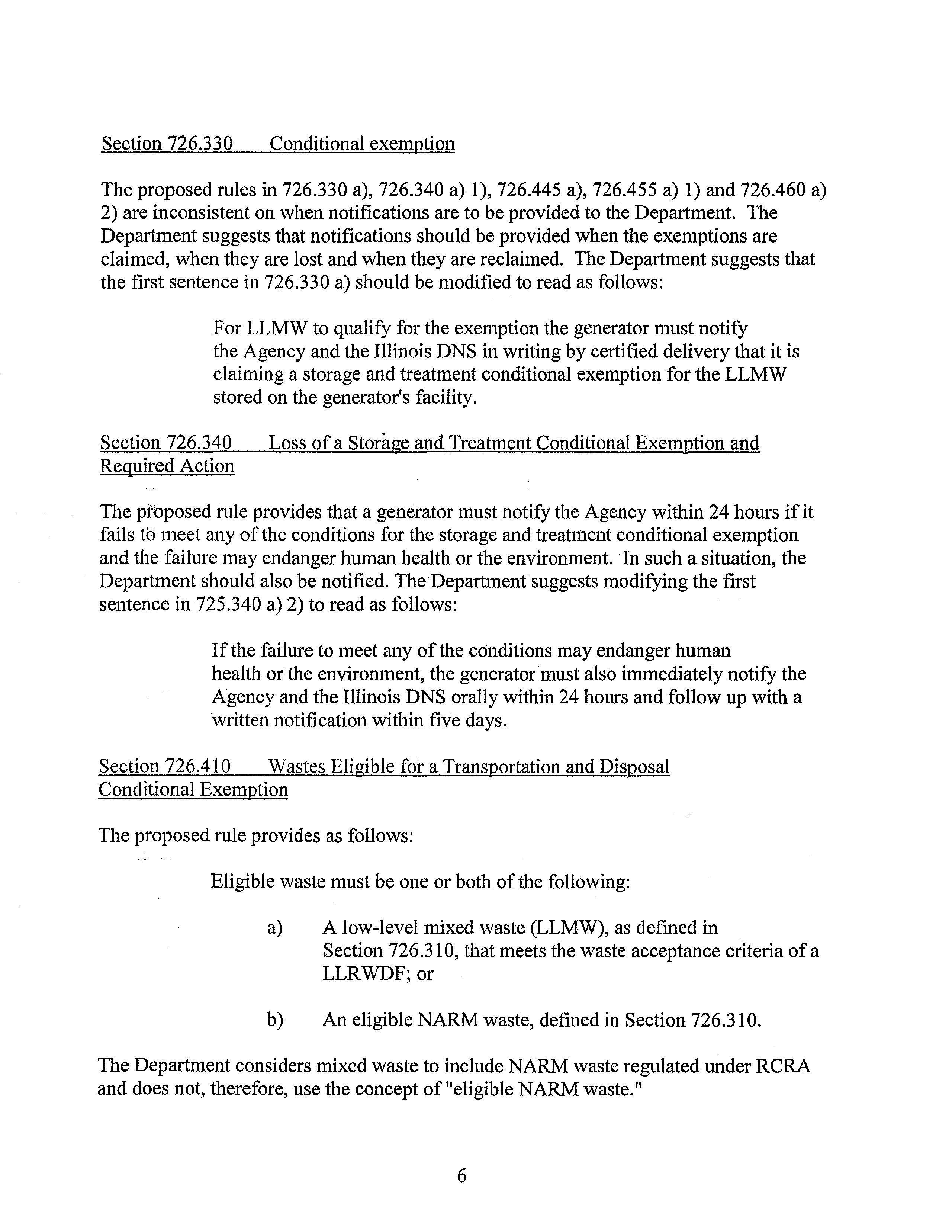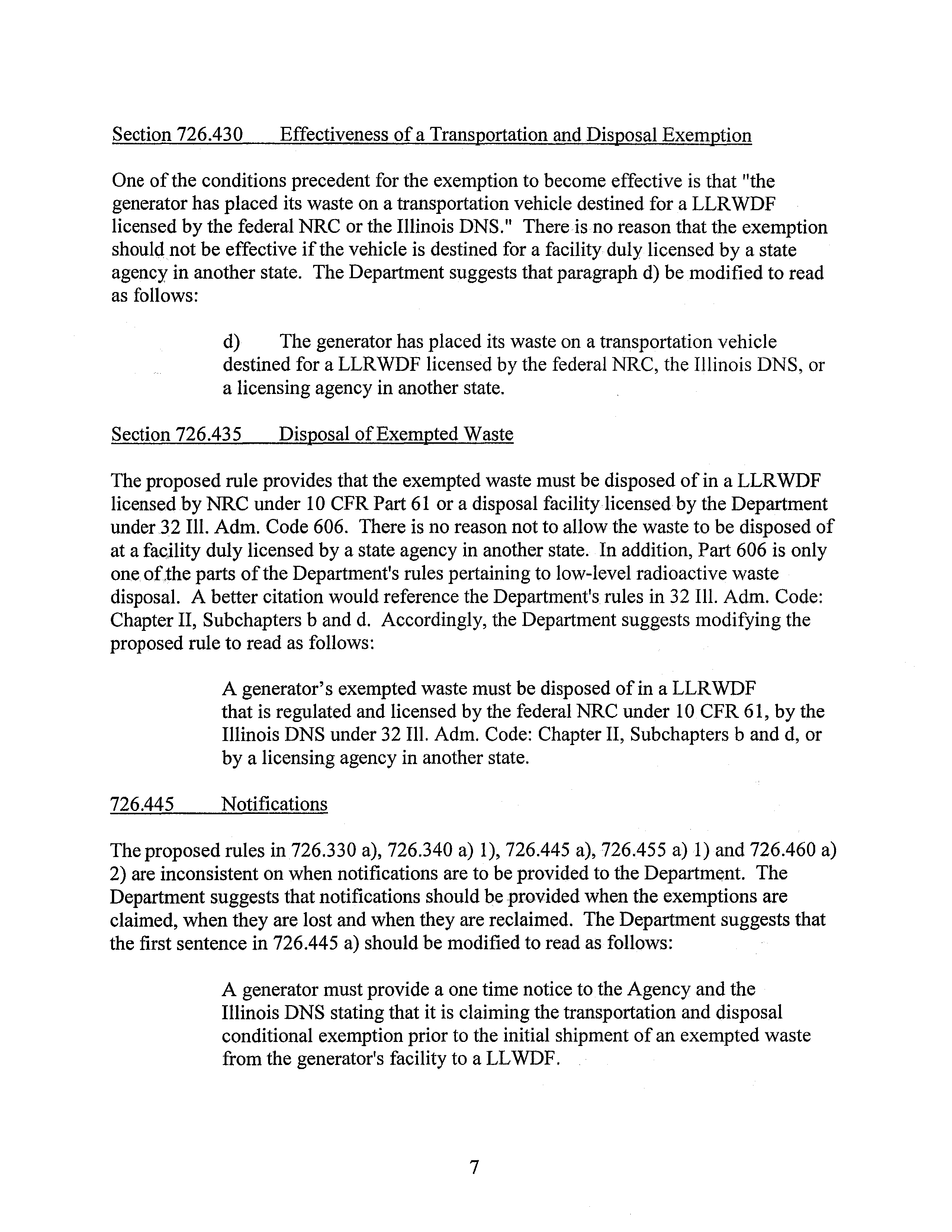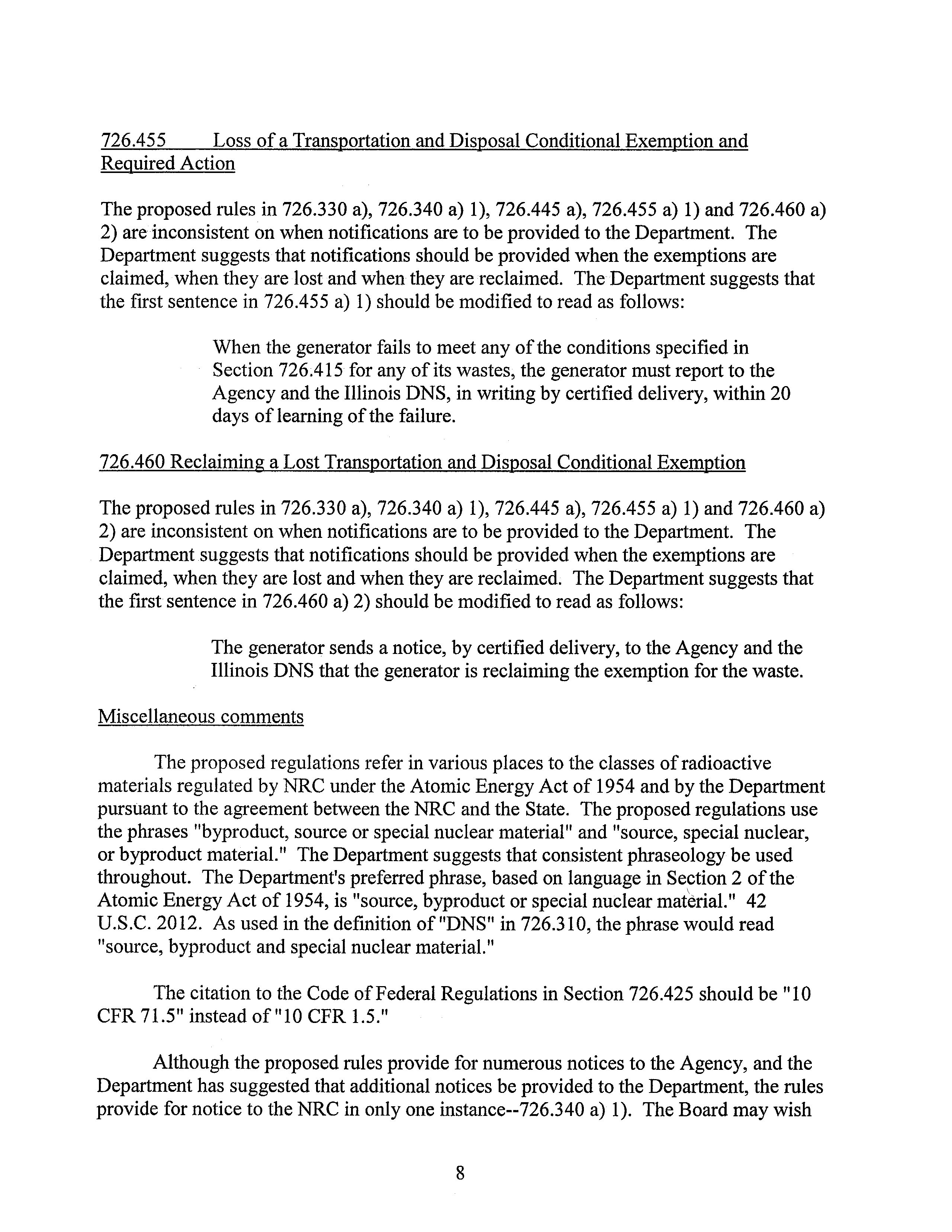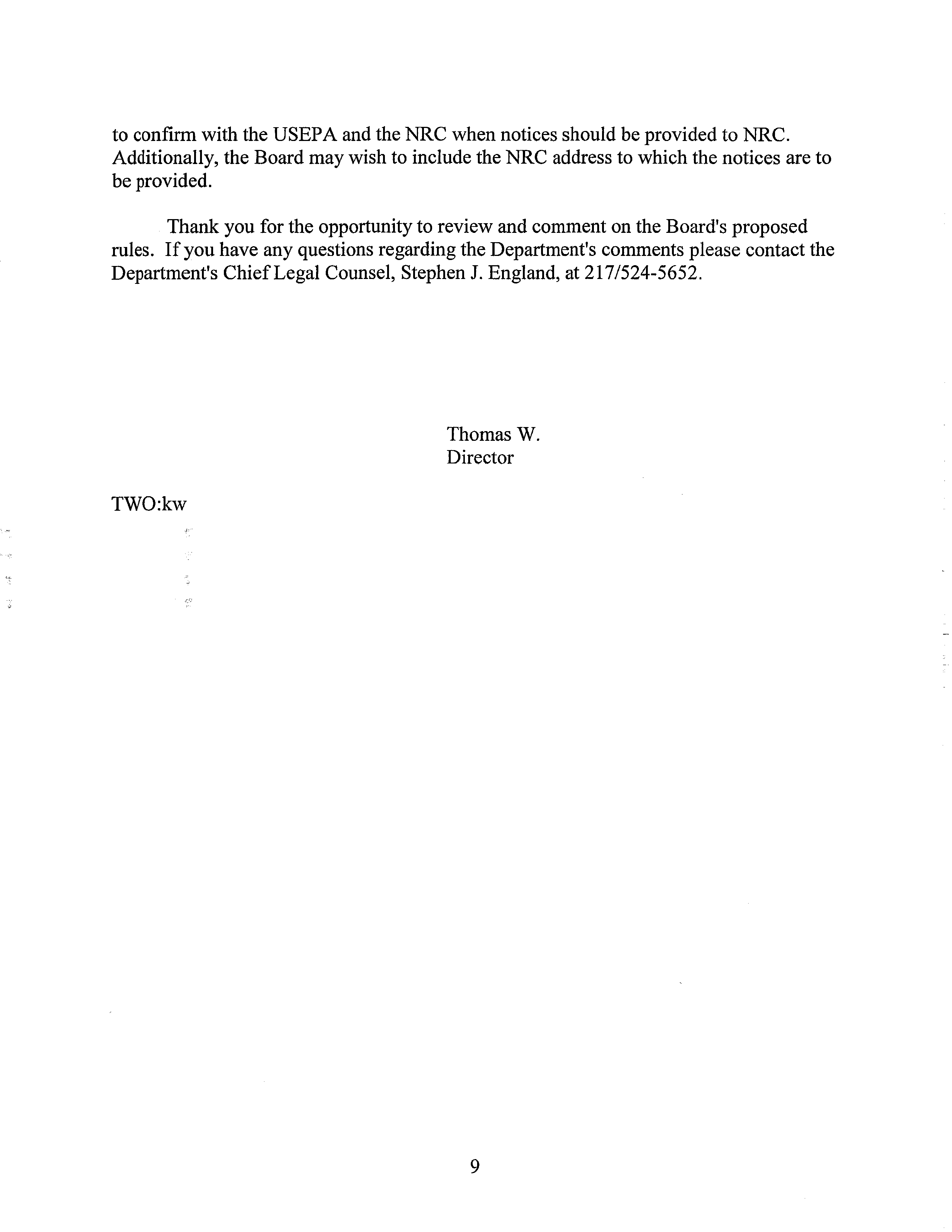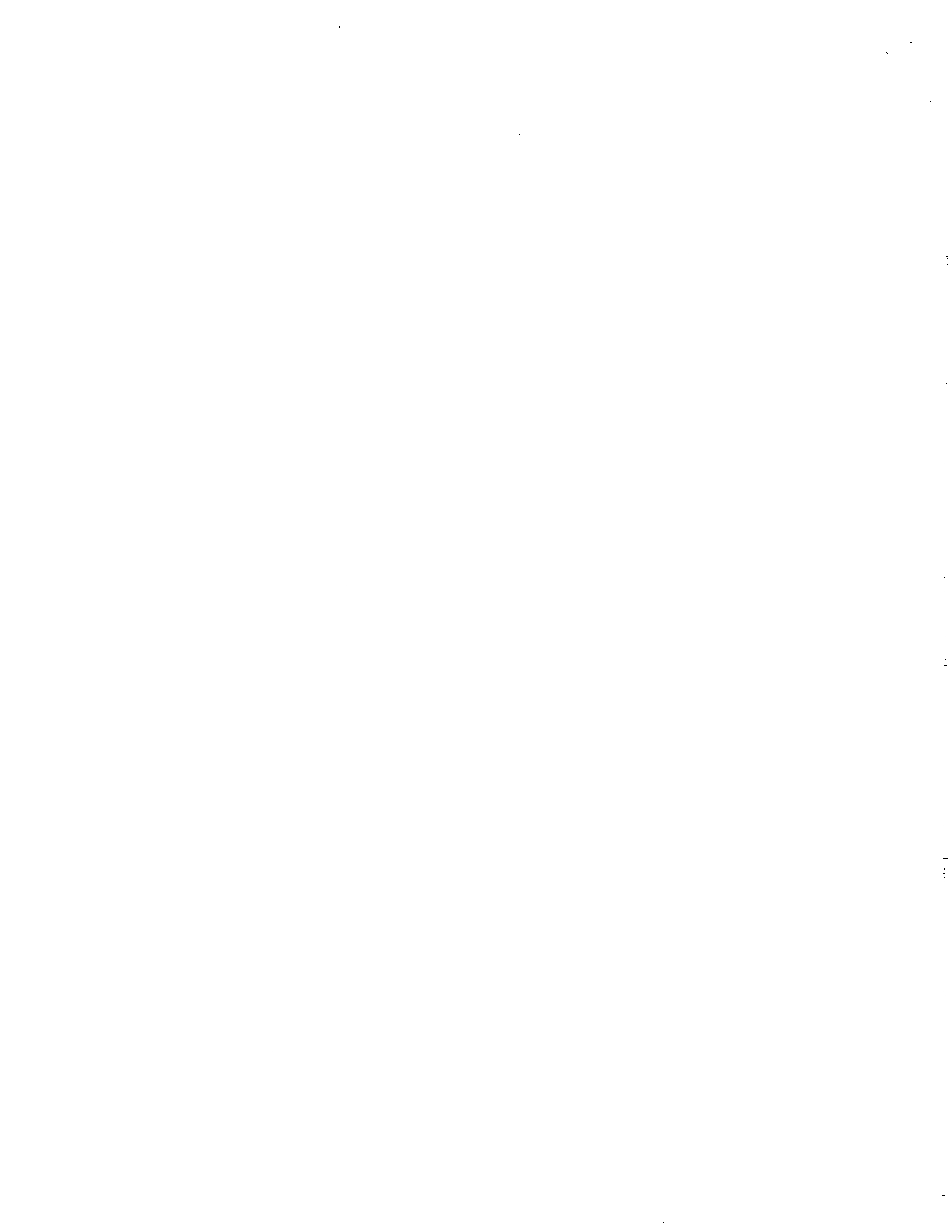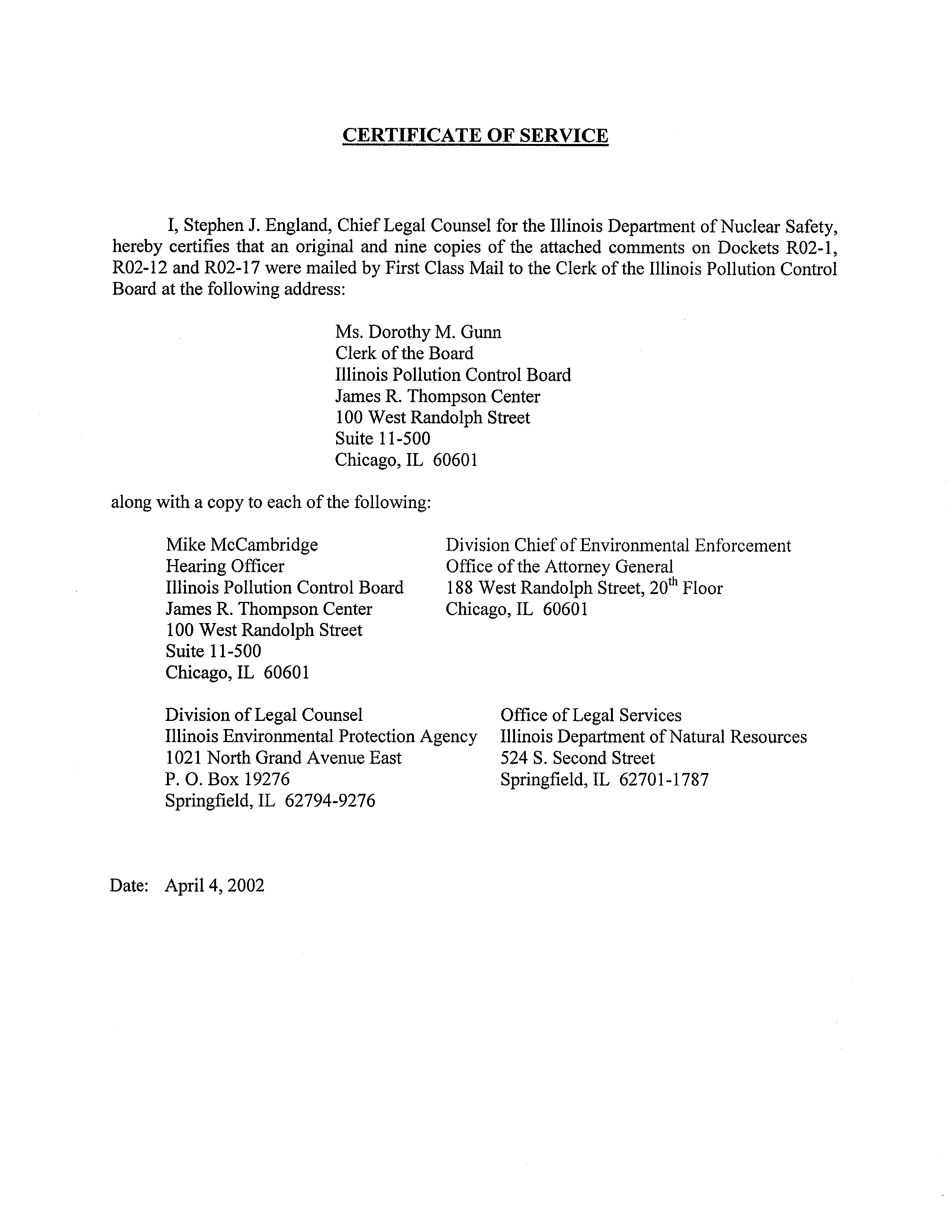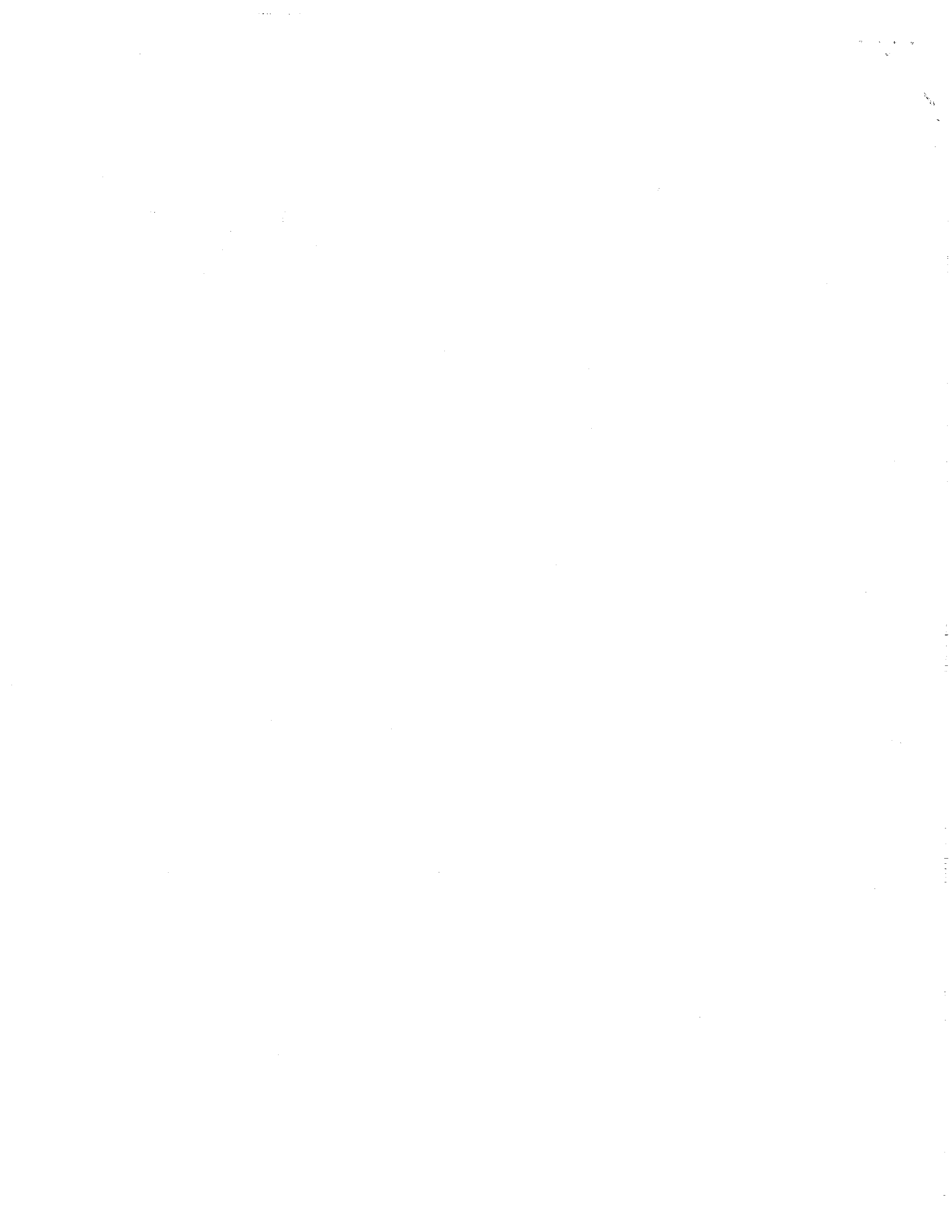DEPARTME
R SAFETY
1035 OUTER
62704
RECEIVED
CLERK’S OFF~..E
George H. Ryan
Thomas W. Ortciger
Governor
Director
APR
-
82002
STATE OF
ILLL1’~UAS
Pollution
Control Board
Ms. Dorothy M. Gunn, Clerk
Illinois Pollution Control Board
State ofIllinois Center, Suite
11-500
100
W. Randolph St.
/t’~e
~
Chicago, IL 60601-3218
7
Re:
Docket R02-1/R02-12/R02-17
Dear Ms.Gunn:
The Illinois Department ofNuclear Safety (“Department”) has reviewed the
proposed rules
in the above-referenced docket and submits these comments.
The Department is responsible for licensing radioactive material under the
Radiation Protection Act of 1990.
420 ILCS 40/1.
That responsibility extends to both
radioactive materials licensed under the federal Atomic Energy Act of 1954 (i.e., source,
byproduct and special nuclear material) and to radioactive materials not licensed under
the Atomic Energy Act (i.e., naturally occurring or accelerator- produced radioactive
material, commonly known as NARM).
Under an agreement between the Governor and
the Chairman ofthe United States Nuclear Regulatory Commission (NRC), the State,
acting through the Department, licenses Illinois entities utilizing source, byproduct and
special nuclear material, except entities licensed by the NRC.
Notably, the NRC licenses
nuclear power plants, federal facilities, a spent fuel
storage facility and a uranium
hexafluoride conversion facility.
Facilities of the United States Department ofEnergy
are self-regulated.
The Department supports elimination ofunnecessary duplicative regulation of
entities with materials regulated under both the Resource Conservation and Recovery Act
(RCRA) and the Atomic Energy Act of
1954.
The Department understands that the
proposed regulations are “identical
in substance”
to regulations adopted by the United
States Environmental Protection Agency (EPA).
Since, however, the NRC does not
regulate NARM, language employed by the EPA regarding low-level radioactive waste
(LLRW) that would be regulated under RCRA reflects a more complicated approach than
April 4, 2002
is taken by the Department.
The differences, which will be discussed in more detail in
the comments below, begin with the EPA’s definition ofLLRW as including only
“radioactive waste that contains source, special nuclear or byproduct material”
and that
does not meet the classification ofone ofthree other types ofradioactive waste while the
Department’s statutory and regulatory definitions ofLLRW include
“radioactive waste”
that does not meet classification ofone ofthe three other types of radioactive waste.
Under the EPA’s rules “mixed waste” means “waste that contains both RCRA hazardous
waste and source, special nuclear, or byproduct material subject to
the Atomic Energy
Act of 1954” and, therefore, excludes NARM.
Under Illinois statutes and regulations,
however,
“mixed waste” means waste that is both hazardous waste under RCRA and
LLRW under Illinois law and, therefore, includes NARM.
The Department does not have a basis to assert that the semantical differences in
the regulation ofmixed NARM waste in any way endanger the public health and safety.
NARM is regulated somewhat differently by states throughout the country, and we do not
believe that the differences have posed any undue risks to the public health and safety.
The Department’s regulations and the NRC’s regulations contain provisions for
exempt concentrations, exempt quantities and exempt items.
32 Ill. Adm. Code 330.30
and 330.40.
The regulations also contain certain exemptions from disposal requirements.
32 Ill. Adm. Code Part 340, Subpart K.
In addition, the Department is developing
comprehensive regulations for one type ofNARM known as technologically enhanced
naturally occurring radioactive materials, or TENORM.
The Department does not
envision that protection ofthe public health and safety will require disposal ofTENORM
only at facilities licensed underNRC’s Part 61
rules or Agreement State
equivalent rules.
It is unclear how the Board’s proposed rules would affect materials that fall within the
definition of “low-level radioactive waste” but are also exempt from licensing
requirements under the Department’s and NRC’s rules.
The Department presumes that
since such materials are not subject to regulatory controls under radiation safety
regulations,
the exemptions in the Board’s proposed rules would not apply and that
applicable RCRA permitting requirements must be complied with.
The Board may wish
to clarify this matter.
Specific Comments
Section 726.310
Definitions
“DNS”
The definition recognizes that the Department regulates byproduct, source
and special nuclear material under agreement bet~veen
the State and the NRC but
does not recognize that the Department is also responsible under 420 ILCS
20/12
2
for regulating radioactive materials not regulated by the NRC.
The Department
suggests that the definition be modified to read as follows:
“DNS” means the Department ofNuclear Safety, the State ofIllinois
agency responsible
for regulating byproduct, source,
and special nuclear
material
in Illinois in
accordance with an agreement between the State and
the federal Nuclear Regulatory Commission (NRC) under section 274(b) of
the federal Atomic Energy Act of 1954, as amended (42
USC 2021(b)) and
for regulating radioactive materials not licensed by the NRC in
accordance
with the Radiation Protection Act of 1990.
“Eligible naturally occurring or accelerator-produced radioactive material”
This definition is necessary only because the EPA, unlike the Department, does
not recognize that mixed waste may include NARM.
The definition is generally
acceptable to the Department, but should be modified to allow for the possibility
that the waste might lawfully be disposed of at a licensed facility in another state.
The only facility that accepts mixed NAR.M from throughout the country for
disposal at the current time is the facility in Clive, Utah, which is operated by
Envirocare ofUtah, Inc.
Additionally, the Board Note after the definition does not
recognize that some ofthe relevant Department regulations are in
Subchapter d of
32111. Adm.
Code: Chapter II.
The Department suggests that the definition be
modified to read as follows:
“Eligible naturally occurring or accelerator-produced radioactive material”
means naturally occurring or accelerator-produced radioactive material
(NARM) that is eligible for a transportation and disposal conditional
exemption. It is a NARM waste that contains RCRA hazardous waste,
meets the waste acceptance
criteria
of,
and is allowed by State NAR~vI
regulations to be disposed ofat a disposal facility licensed in accordance
with
10
CFR 61, DNS
regulations or the regulations of a licensing agency
in another state.
BOARD NOTE:
The relevant Illinois DNS regulations are codified at 32
Ill. Adm.
Code:
Chapter II, Subchapters b and d.
“Low-level radioactive waste”
The term is defined in the proposed rules as follows:
“Low-level radioactive waste” or “LLW” is a radioactive waste that
contains source,
special nuclear, or byproduct material and which is not
classified as high-level radioactive waste, transuranic waste, spent nuclear
fuel, or byproduct material, as defined in
section
11 (e)(2) of the Atomic
3
Energy Act of 1954 (42 USC 2014(e)(2)).
(See also the NRC definition of
waste at
10 CFR 61.2.)
The Department recognizes that “low-level radioactive waste”
is defined as
it
is defined in the EPA’s rules.
The Department points out that this definition of
the term is not the same as the definition in the Low-Level Radioactive Waste
Management Act (420 ILCS
20/3 (k)), the Department’s rules (20 Ill. Adm. Code
606.20 g)) and the Central Midwest Interstate Low-Level Radioactive Waste
Compact
(45
ILCS
140/1, Article II k.).
For its regulatory purposes, the
Department considers
“low-level radioactive waste” to have the following
meaning from 20 Ill. Adm.
Code 606.20 g):
radioactive waste not classified as high-level radioactive waste as defined
in Section
2 ofthe Nuclear Waste Policy Act of 1982, 42 U.S.C.
10101,
transuranic waste, spent nuclear fuel or byproduct material as defined in
Section
1 le(2) ofthe Atomic Energy Act of 1954, 42
U.S.C. 2014.
Except
when otherwise indicated in the rules, low-level radioactive waste includes
“mixed waste.”
Additionally, the Department prefers “LLRW” to “LLW.”
“Low-level radioactive waste disposal facility” or “LLRWDF”
The Department’s suggested revision ofthe defmition of“Eligible naturally
occurring or accelerator-produced radioactive niaterial” deletes the language
defining “Low-level radioactive waste disposal facility” or “LLRWDF.”
The
Department suggests that a definition be added for that term, providing as follows:
“Low-level radioactive waste disposal facility” or “LLRWDF”
means a disposal facility licensed by the NRC under
10 CFR 61, by the
Illinois DNS under 32 Ill. Adm.
Code:
Chapter II, Subchapters b and d, or
by a licensing agency in another state.
“Mixed waste”
The term is defined in the proposed rules as follows:
“Mixed waste” means a waste that contains both RCRA hazardous waste
and source,
special nuclear, or byproduct material subject to the Atomic
Energy Act of
1954,
as amended (42 USC 2014
et seq.).
The Department recognizes that the term “mixed waste” is defined as
4
it is defined in the EPA’s rules.
The Department points out that this definition of
the term is not the same as the definition in the Low-Level Radioactive Waste
Management Act (420 ILCS 20/3
(1)) and the Department’s rules (20 Iii. Adm.
Code 606.20 h)).
For its regulatory purposes, the Department considers
“mixed
waste” to have the following meaning from 20 Iii. Adm. Code 606.20 h):
“Mixed Waste” means waste that is both “hazardous waste” and “low-level
radioactive waste” as defined in the
Low-Level Radioactive Waste
Management Act.
The Department considers that mixed waste may include either NARM or
radioactive materials regulated under the Atomic Energy Act of
1954.
“Naturally occurring or accelerator-produced radioactive material” or “NARM”
While the proposed rule recognizes that NARM is regulated
by the Department
and the U.S. Department ofEnergy (DOE), it does not recognize that some ofthe
relevant Department regulations are in Subchapter d of32 Ill. Adm. Code: Chapter
II or that DOE regulates NARM under both regulations and orders.
The
Department suggests that the Board Note for the definition be modified to
read as
follows:
BOARD NOTE: NARM is regulated by the State, under the
Radiation Protection Act of 1990
420
ILCS 40
and 32 Ill. Adm.
Code:
Chapter II, Subchapters b and d, or by the federal Department ofEnergy
(DOE), as authorized by the federal Atomic
Energy Act (42
USC 2014
et
seq.), under DOE regulations and orders.
Section 726.325
Wastes Eligible for
a Storage and Treatment Conditional Exemption
for Low-Level Mixed Waste
Under the proposed rule, “low-level mixed waste” is eligible for a storage and treatment
conditional exemption,
while “NARM waste” is not.
The Department has no objection to
this provision but points out that the Department considers
“mixed waste” to include
NARM waste regulated underRCRA.
The Department suggests that the Pollution
Control Board may wish at some time in the future to reconsider allowing “NARM
waste” to be eligible for a storage and treatment conditional exemption.
5
Section 726.330
Conditional exemption
The proposed rules in 726.330
a), 726.340
a)
1), 726.445
a), 726.455
a)
1) and 726.460
a)
2) are inconsistent on when notifications are to be provided to the Department.
The
Department suggests that notifications should be provided when the exemptions are
claimed, when they are lost and when they are reclaimed.
The Department suggests that
the first sentence in 726.330 a) should be modified to read as follows:
For LLMW to qualify for the exemption the generator must notify
the Agency and the Illinois DNS
in writing by certified delivery that it is
claiming a storage and treatment conditional exemption for the LLMW
stored on the generator’s facility.
Section 726.340
Loss of a Storage and Treatment Conditional Exemption and
Required Action
The proposed rule provides that a generator
must notify the Agency within 24 hours ifit
fails to meet any of the conditions
for the storage and treatment conditional exemption
and the failure may endanger human health or the environment.
In such a situation, the
Department should also be notified. The Department suggests modifying the first
sentence in 725.340
a) 2) to read as follows:
Ifthe failure to meet any ofthe conditions may endanger human
health or the environment, the generator must also immediately notify the
Agency and the Illinois DNS
orally within 24 hours and follow up with a
written notification within five days.
Section
726.4 10
Wastes Eligible for a Transportation and Disposal
Conditional Exemption
The proposed rule provides as follows:
Eligible waste must be one or both ofthe following:
a)
A low-level
mixed waste (LLMW), as defined in
Section 726.310, that meets the waste acceptance criteria ofa
LLRWDF;
or
b)
An eligible NARM waste, defined in
Section 726.3 10.
The Department considers mixed waste to include NARM waste regulated under RCRA
and does not, therefore, use the concept of“eligible NARM waste.”
6
Section 726.430
Effectiveness ofa Transportation and Disposal Exemption
One ofthe conditions precedent for the exemption to become effective
is that “the
generator has placed its waste on
a transportation vehicle destined for a LLRWDF
licensed by the federal NRC or the Illinois DNS.”
Thereisno reason that the exemption
should not be effective ifthe vehicle is destined for a facility duly licensed by
a state
agency in another state.
The Department suggests that paragraph d) be modified to read
as follows:
d)
The generator has placed its waste on a transportation vehicle
destined for a LLRWDF licensed by the federal NRC, the Illinois DNS, or
a licensing agency in another state.
Section 726.435
Disposal of Exempted Waste
The proposed rule provides that the exempted waste must be disposed of in a LLRWDF
licensed by NRC under
10
CFR Part 61
or a disposal facility licensed by the Department
under 32 Ill. Adm. Code 606.
There is no reason not to allow the waste to be disposed of
at a facility duly licensed by a state agency in another state.
In addition, Part 606 is only
one ofthe parts ofthe Department’s rules pertaining to
low-level radioactive waste
disposal.
A better citation would reference the Department’s rules in 32 Ill. Adm. Code:
Chapter II, Subchapters b and d.
Accordingly, the Department suggests modifying the
proposed rule to read as follows:
A generator’s exempted waste must be disposed ofin a LLRWDF
that is regulated and licensed by the federal NRC under
10
CFR 61, by the
Illinois DNS under 32 Ill. Adm.
Code:
Chapter II, Subchapters b and d, or
by a licensing agency in another state.
726.445
Notifications
The proposed rules in 726.330 a), 726.340
a)
1), 726.445
a), 726.455
a)
1) and 726.460 a)
2) are inconsistent on when notifications are to be provided to the Department.
The
Department suggests that notifications should be provided when the exemptions are
claimed, when they are lost and when they are reclaimed.
The Department suggests that
the first sentence in 726.445
a) should be modified to read as follows:
A generator must provide a one time notice to the Agency and the
Illinois DNS stating that it is claiming the transportation and disposal
conditional exemption prior to the initial shipment ofan exempted waste
from the generator’s facility to a LLWDF.
7
726.455
Loss ofa Transportation and Disposal Conditional Exemption and
Required Action
The proposed rules in 726.330 a), 726.340
a)
1), 726.445
a), 726.455
a)
1) and 726.460 a)
2) are inconsistent on when notifications are to be provided to the Department.
The
Department suggests that notifications should be provided when the exemptions are
claimed, when they are lost and when they are reclaimed.
The Department suggests that
the first sentence in 726.455 a)
1) should be modified to read as follows:
When the generator fails to meet any ofthe conditions specified in
Section 726.415 for
any of its wastes, the generator must report to the
Agency and the Illinois DNS, in writing by certified delivery, within 20
days oflearning ofthe failure.
726.460 Reclaiming a Lost Transportation and Disposal Conditional Exemption
The proposed rules in 726.330 a), 726.340 a)
1),
726.445 a), 726.455 a)
1) and 726.460 a)
2) are inconsistent
on when notifications are to be provided to
the Department.
The
Department suggests that notifications should be provided when the exemptions are
claimed, when they are lost and when they are reclaimed.
The Department suggests that
the first sentence in
726.460 a) 2) should be modified to read as follows:
The generator sends a notice, by certified delivery, to the Agency and the
Illinois DNS that the generator is reclaiming the exemption for the waste.
Miscellaneous
comments
The proposed regulations refer in various
places to the classes ofradioactive
materials regulated
by NRC under the Atomic Energy Act of 1954 and by the Department
pursuant to the agreement between the NRC and the State.
The proposed regulations use
the phrases “byproduct, source or special nuclear material” and “source, special nuclear,
or byproduct material.”
The Department suggests that consistent phraseology be used
throughout.
The Department’s preferred phrase, based on
language in Section 2 ofthe
Atomic Energy Act of
1954,
is
“source, byproduct or special nuclear material.”
42
U.S.C. 2012.
As used in the definition of”DNS”
in 726.3 10, the phrase would read
“source, byproduct and special nuclear material.”
The citation to
the Code ofFederal Regulations in
Section 726.425 should be
“10
CFR 71.5” instead of”lO CFR
1.5.”
Although the proposed rules provide for numerous notices to
the Agency, and the
Department has suggested that additional notices be provided to the Department, the rules
provide for notice to the NRC in
only one instance--726.340 a)
1).
The Board may wish
8
to confirm with the USEPA and the NRC when notices should be provided to NRC.
Additionally, the Board may wish to include the NRC address to which the notices are to
be provided.
Thank you for the opportunity to review and comment on the Board’s proposed
rules.
Ifyou have any questions regarding the Department’s comments please contact the
Department’s ChiefLegal Counsel, Stephen J. England, at 217/524-5652.
TWO:kw
Thomas W.
Director
9
CERTIFICATE OF SERVICE
I, Stephen J. England, ChiefLegal Counsel for the Illinois Department ofNuclear Safety,
hereby certifies that an
original
and nine
copies
of the
attached
comments on
Dockets
R02- 1,
R02-l2 and R02-17 were mailed by First Class Mail to
the Clerk ofthe Illinois Pollution Control
Board at the following address:
Ms. Dorothy M. Gunn
Clerk ofthe Board
Illinois Pollution Control Board
James R. Thompson Center
100 West Randolph Street
Suite 11-500
Chicago, IL
60601
along with a copy to each ofthe following:
Mike McCambridge
Hearing Officer
Illinois Pollution Control Board
James R. Thompson Center
100 West Randolph Street
Suite 11-500
Chicago, IL
60601
Division Chiefof Environmental Enforcement
Office of the Attorney General
188 West Randolph Street,
20th
Floor
Chicago, IL
60601
Division ofLegal Counsel
Office ofLegal Services
Illinois Environmental Protection Agency
Illinois Department ofNatural Resources
1021
North Grand Avenue East
524 S.
Second Street
P. 0. Box
19276
Springfield, IL
62701-1787
Springfield, IL
62794-9276
Date:
April 4, 2002
